|
Celluloid Cylinders: "Albany" Indestructible vs. U-S Everlasting
by Bill Klinger
Fig. 1 - Indestructible Phonographic Record
The oval-design label was printed blu/gry/wht and used to package
2m cylinders. A similar
oval-design
label in brn/gry/wht (not pictured) was
used for 4M records. The linear-design
[2m] label is simply blk/wht.
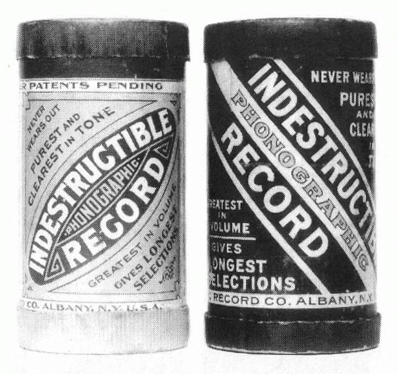
|
|
The first commercial
celluloid cylinders in
North America were the colorful Lambert
Indestructible Records,
manufactured in
Chicago from 1900 through 1905. These lightweight
records (colored white, brown, pink or black) were made
of relatively thick, self-supporting celluloid, generally
without any underlying core material. Their production was on a small scale and they are rather rare today.
Indestructible Brands
The cylinder records made by the Indestructible
Phonographic Record Company (IPRCo) of Albany,
New York were the first celluloid cylinders to enjoy
truly widespread distribution and acceptance. Though
still commonly found, these "Indestructible" cylinders
are sometimes misunderstood. This may be because
these records are not
marked with any distinctive brand or company
name and were originally
sold under various brand
names, in a variety of containers.
IPRCo had a rather complex corporate origin and
business evolution, but eventually acquired some
patent rights, technology, and manufacturing equipment from the defunct Lambert Company.
The Albany-made cylinders have a characteristic
spiral-wound cardboard-tube core, reinforced with
metal rings at each end of the tube. Almost all have the
celluloid surface dyed black. The earliest ones (advertised during the summer of 1907 and first released in
November 1907) had raised-letter title markings on
their end rims, with the celluloid flange embossed in
the style of late Lambert records. They also bear the
July 29, 1902 Grant Date of a William E. Messer patent
(U.S. 705772, for cylinder manufacturing apparatus)
that was a legacy from the Lambert Company.
Fig. 2 - Columbia Overlabel on IPRCo Box
Some IPRCo boxes were
overlabelled with this red/wht paper strip when Columbia began their exclusive
[?] distribution of the Albany product.
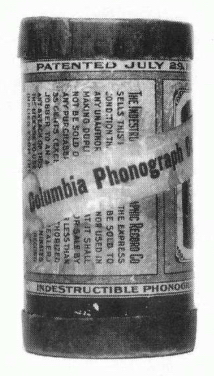
|
|
Fig. 3 - Columbia Gold Moulded Indestructible
Cylinder Record
2m box, front and back: red/blu-blk/wht.
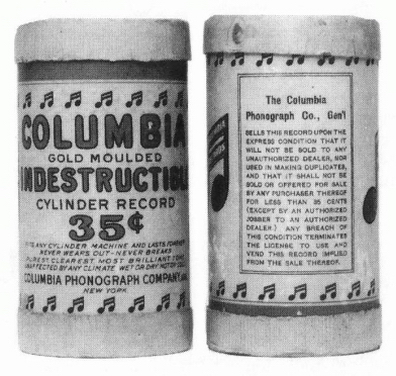
|
|
The Indestructible Records soon were marked in a
more legible fashion, with the Record Number, Title
and Patent Date impressed into the title-
end rim and filled with
white pigment.
First sold
directly by IPRCo as the
Indestructible
Phonographic Record
(Fig.
1), sale continued as:
Fig. 4 - Columbia Gold Moulded 4-Minute Indestructible Cylinder Record
4M box, front and two back variants: blu/gld/wht or blu/org/wht.
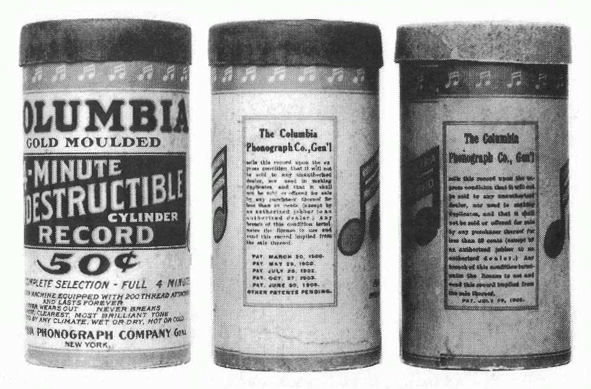
|
|
Columbia Gold Moulded Indestructible
Cylinder Record
(Fig. 2, 3, and 4; distributed by
the Columbia Phonograph Co., Gen'l, from
September 1908 through May 1912),
Fig. 5 - Oxford Indestructible Cylinder Record
L to R: [2m]: grn/gry/wht;
2m:
blu/gry/whe;
4m: brn/gry/wh.
Not to be confused with the earlier wax Oxford cylinders
made
by Columbia and packed in felt-lined
boxes.

|
|
Oxford Indestructible Cylinder Record
(Fig. 5; offered in Sears, Roebuck & Co. catalogs
from Fall 1911 through Winter 1921; some were
colored a light blue or bluish gray),
Fig. 6 - Lakeside Indestructible Cylinder Record
These labelstyles (grn/ylw/wht) were used by Montgomery Ward for
both 2m and 4m records,
made by U-S Phonograph Co and IPRCo.
2M lid label: blk/wht; 4m lid label: red/wht.

|
|
Lakeside Indestructible Cylinder Record
(Fig. 6; mail-order marketed by Montgomery
Ward & Co. of Chicago, from Fall 1914 through
Summer 1917),
Fig. 7 - Everlasting Indestructible Record
2m: blk/grn/wht; 4m: blk/red/wht. The two side/back views shown in
the centre appear on both 2m and 4m boxes.
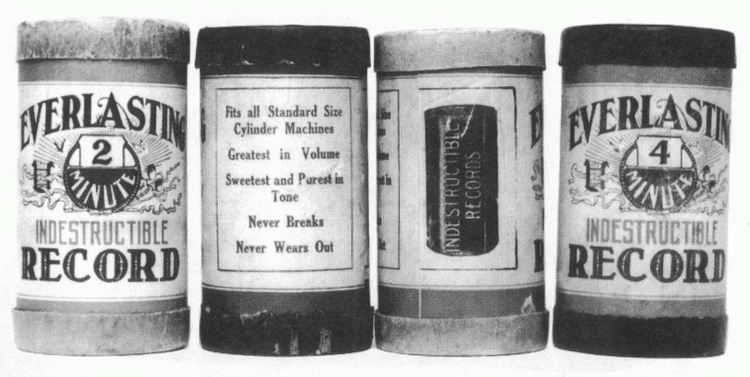
|
|
Everlasting Indestructible Record (Fig. 7; probably marketed directly by IPRCo, circa 1914-?), and as
Federal Cylinder Record (after a corporate name
change from IPRCo to Federal Record
Corporation an June 1, 1917), through 1922. No
distinctive "Federal" cylinder box labels have yet
been reported.
Collectors have sometimes taken these records to be
different products, interpreting the various record
boxes to indicate manufacture by Columbia, by the
maker of U-S Everlasting Records, or perhaps by some
other firm for Sears and Montgomery Ward. However,
all the brand names cited were actually used for the
same cylinders — made in Albany, numbered and
marked identically — but packaged in boxes with different labels. (Once separated from the original box and
lid, these records lose their specific brand identity.)
Many collectors refer to these cylinders generically
as "Indestructible" records.
I suggest the term "Albany
Indestructible"
(AI), to emphasize their common
source and to distinguish them from at least ten other
cylinder brands that included the word "indestructible"
in their trade names.
Albany Indestructibles
were assigned catalog
numbers and issued as follows:
|
Series
|
Number Range
|
Issue Dates
|
|
2M Domestic U.S.
|
472-1574
|
November 1907 - 1918
|
|
4M Domestic U.S.
|
3001 - 3524
|
January 1910 - 1921
|
|
2M British
|
6001 - 6040
|
May 1910 (all issued this month)
|
|
4M British
|
7001 - 7094
|
September 1910 - December 1911
|
Some early two-minute AI records were not issued in a
regular, consecutively-numbered series. It has been suggested that IPRCo initially used a block-numbering
system, but the unbroken blocks of numbers do not
match up with the artists or musical categories represented. Known examples
of the first two dozen or so
issues do not bear matrix and record numbers together;
it appears that the matrix (or recording log?) number also
served as the catalog/record number for the selections
chosen for release. Consecutive numbering began at
Record Number 663; distinct matrix and take numbers
also began to appear around that point.
U-S Brands
Two other brands of black celluloid cylinders at times
competed with Albany Indestructibles:
U-S Everlasting
(Fig. 8) and Lakeside (Fig. 6), both manufactured by
the U-S Phonograph Company in Cleveland, Ohio,
between 1910 and 1913.
Fig. 8 - U-S Everlasting Record
L to R: [2m]: red/blk/wht; 2m Grand Opera: gld/blu; 4m Grand Opera:
gld/lavender (same design as 2m Grand Opera, not pictured); 4m: gld/brn/wht.
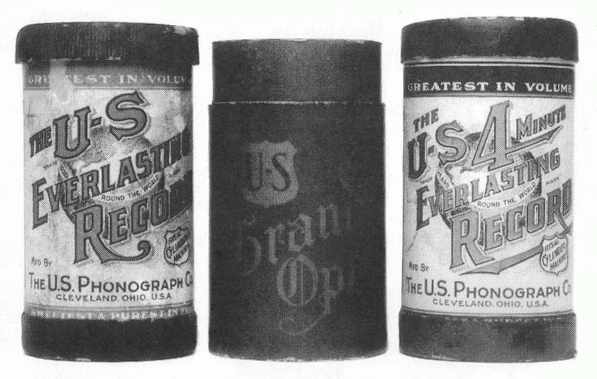
|
|
These "U-S" cylinders can be recognized by their
smooth, black, tapered bore — no internal ribs or metal
rings. The grooved record surface was formed on a simple
celluloid tube, without any end-flange. The thin-walled
tube is supported by a preformed core of compressed
wood-pulp, impregnated with wax and asphalt resin.
The title-end rims of standard-production U-S
Everlasting and Lakeside records are impressed with the
respective brand name. Additionally, the rims of U-S
Everlasting Records include the Patent Grant Date of
December 11, 1906 (U.S. 837927), identifying the
record construction developed by Varian M. Harris.
Early-production records had the end-rim lettering
filled with colored pigments; later ones did not.
U-S records were released in two series of "popular" material:
|
Series
|
Number Range
|
Issue Dates
|
|
2M
|
201 - 526
|
May 1910 - February 1913
|
|
4M
|
1001 - 1652
|
May 1910 - October 1913
|
An initial group of U-S record moulds was rejected
because of poor quality, so the series of 2M releases
actually began at Number 201, after those early moulds
were scrapped. Several higher-numbered series were
dedicated in blocks to ethnic and operatic selections.
These catalog number ranges provide further keys
to distinguish most Albany Indestructibles from U-S
records: 1) the four-minute popular series do not overlap at all [numerically] and 2) only a very few numbers
appear in both the AI and U-S two-minute lists.
The U-S Phonograph Co. supplied Lakeside-branded cylinders for Montgomery Ward's catalog sales
(the same titles, numbered the same as the U-S
Everlasting releases). This relationship continued until
the U-S Phonograph Co. ceased production, in late
1913 or 1914.
Thereafter, Montgomery Ward drew their
Lakeside cylinders from IPRCo's
Indestructible line.
Fig. 9 - Cortina Language Record
Blk/wht; distinct from the earlier wax Cortina records in felt-lined boxes.
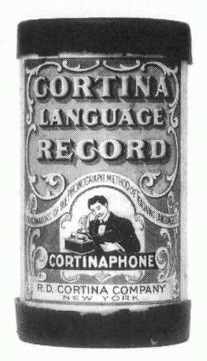
|
|
Fig. 10 - U-S Medicophone
Front and back: blk / lt blu.
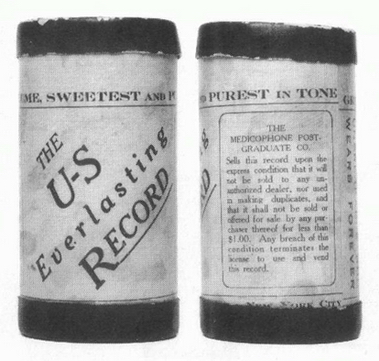
|
|
U-S Phonograph Co. also manufactured:
-
the celluloid Cortina Language Record (Fig. 9),
for the R. D. Cortina Company of New York
City, offering instruction in a variety
of foreign
languages, and
-
the seldom-seen Medicophone (Fig. 10) series, for
dissemination of medical information to doctors
by the Medicophone Post-Graduate Company,
also of New York City.
All "U-S" brands were made with identical materials
and construction.
Confusing Boxes
It is the Everlasting
Indestructible
Record boxes (Fig. 7)
that cause the greatest confusion, because they bear
both words
— "Everlasting" and "Indestructible" — on
their labels. With no company name or location stated
anywhere on these boxes, it is easy to misconstrue the
origin of the records they originally contained.
As far as is known, these boxes were used solely
for Albany Indestructible records. The halftone illustration along the side of the Everlasting Indestructible
boxes depicts the same cylinder record as shown on the
earlier blue-, brown- and black-label Indestructible
Phonographic Record boxes: Record Number 575,
"Overture to Semiramide," was an early IPRCo 2M
release. (By contrast, U-S two-minute record numbers
had not reached 575 by the time U-S Phonograph Co.
folded.) The pictured cylinder end rim also bears the
July 29, 1902 patent date — associated only with
Lambert and IPRCo, not U-S.
The Albany firm must have begun using the term
"Everlasting" after U-S Phonograph stopped manufacturing cylinders. (None
of the earlier Albany
Indestructible boxes carried the word "Everlasting".)
It is known that IPRCo obtained some late U-S matrices
from the failing Cleveland company, so the rights to
use the word "Everlasting" (if any legal right existed)
could have been conveyed as part of that same deal.
The U-S cylinders occasionally found in
Everlasting Indestructible boxes were presumably put
there by owners or collectors misled by the word
"Everlasting" on the box label. "Genuine" U-S
Everlasting boxes also picture a cylinder on their labels,
but U-S Phonograph Co. apparently chose to depict
fictitious records, perhaps so as not to single out any
one particular title. Two-minute U-S boxes show a
Record Number 100, "Armourer's Song," yet U-S 2M
releases began well beyond Number 100 and no such
title has been found in any available U-S listing. Four-
minute labels display a Record Number 500, "Belle
Brandon," but the lowest 4M U-S issue was Number
1001. (The only U-S "Belle Brandon" known is
Number 1081.)
Conclusion
When you see a cylinder record marked "Everlasting"
or "Lakeside," you'll know it is from the U-S Phonograph
Company in Cleveland. If a record has metal rings and
a cardboard core, it is an "Indestructible"
from IPRCo in Albany.
Editor's note: Detailed references for all the information
in this article are maintained in the author's database on
the cylinder record industry; space does not permit a
listing here. If you have comments on this subject or are
interested in the history of the cylinder record industry,
you can write or call: Bill Klinger, 13532 Bass Lake Road,
Chardon, Ohio, 44024. (216) 564-9340.
The photographs accompanying this article were
taken by Jeff Guerrant (Glenview, Illinois) of cylinder
boxes in the collection of CAPS member Dale Monroe-Cook. If you know of an unusual cylinder box type or
label style, please let Dale know about it: his address is
740 S. Lyman Avenue, Oak Park, Illinois, 60304.
(708) 848-3779.
|